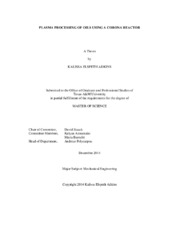| dc.description.abstract | As the demand for energy grows, all available resources will have to be utilized. Heavy oils are one underutilized resource that represents 50% of all the oil resources, but only accounts for 10% of all oil production. Heavy oils are most valuable once they have been refined. Current methods of breaking long hydrocarbon chains include thermal cracking, coking, visbreaking, hydrocracking, and catalytic cracking. This thesis investigates an alternate process, specifically the ability of nonthermal corona plasma to crack heavy and extra heavy crude oil. Preliminary experiments determined the optimal electrode configuration and the temperature at which the oil should be processed in order to achieve a maximum current. These experiments were carried out in air at atmospheric pressure inside a fume hood. The variables considered were the number of high voltage points, the distance between the surface of the oil and the high voltage electrode, the depth of the oil, and the temperature of the oil. It was found that a higher temperature or a lower viscosity increased the conductivity of the heavy oil. A hexagonal multipoint high voltage electrode distributed the discharge over the cross sectional area of the oil while increasing the maximum current that could be applied to the oil before sparking occurred. The optimum distances for the multipoint-to-plane corona discharge were 30 mm between the electrodes and an oil depth of 15 mm. The preliminary experimental results were applied toward the final experimental determination of the cracking abilities of the corona reactor.
To capitalize on the fact that distillation towers are readily available in industry, one was constructed to contain the corona reactor. Distillation towers are used in refineries to separate different oil fractions by their boiling points. The entire tower was heated and the all the light condensates were separated from the heavy residue in a single batch process. The masses of the condensate and the residual were recorded to quantify the efficiency of the corona reactor in producing light oil. The corona discharge yielded more condensates than its control counterparts which were only thermally treated, however, the mass produced was often within uncertainty. | en |


